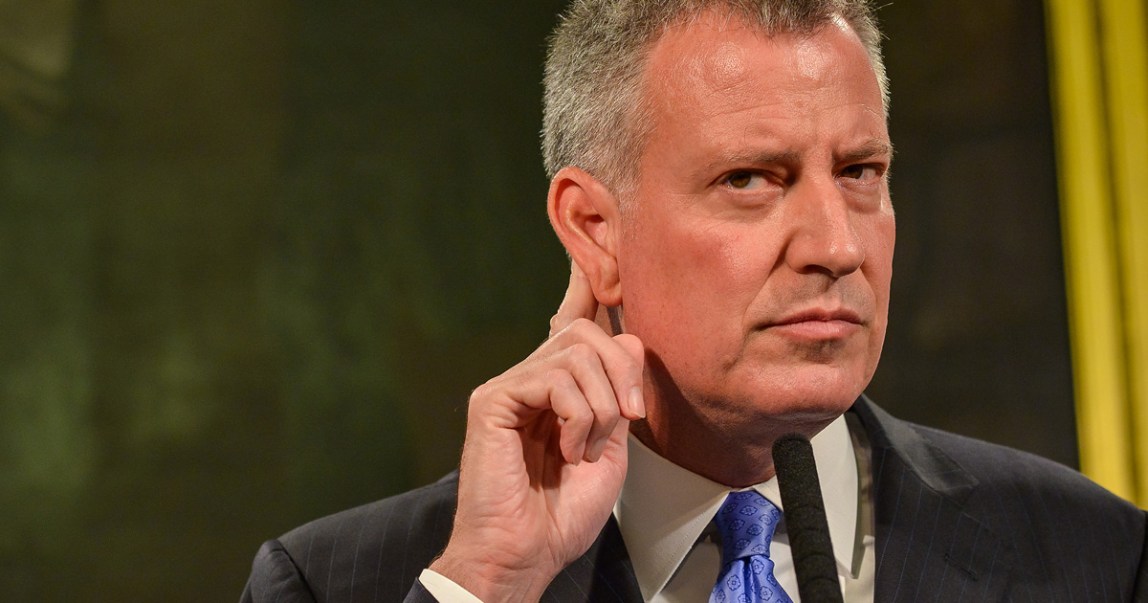On Thursday, Mayor Bill de Blasio and New York Attorney General Eric Schneiderman proudly announced they plan to steer $5 million collected from a “crackdown” on landlords who abused tax breaks to build affordable housing in New York City.
At a news conference, de Blasio and Schneiderman billed the move as a victory for oversight of programs that dole out millions of dollars in tax breaks each year to landlords in exchange for agreeing to limit rent increases and abide by other tenant protections.
“When you see that there are real teeth behind the enforcement of the law, when bad actors see other folks being hit with these penalties, it sends a very powerful message,” de Blasio said.
Schneiderman called it “the most aggressive coordinated effort to deal with New York’s housing crisis that I think the city has ever seen.”
Help Us Investigate New York City Rents
Is your rent legal? It might not be. Your landlord might be charging you too much, and we want your help figuring that out. Learn more.
No one would dispute the value of tough enforcement, but the portrayal of the state and city as aggressive enforcers of the rules on tax break provisions stands in sharp contrast to our reporting.
City officials have acknowledged that they’ve done a poor job of tracking projects in the biggest tax-break program, 421-a, after they are approved (although they say this is changing now); in the past, they also haven’t enforced a law that requires service workers at buildings getting tax subsidies to receive higher wages and benefits.
“I think it’s great that we are having additional development of affordable housing, but what is missing is the failure of the government to regulate our tax subsidies and ensure that our subsidies are going to affordable housing,” said Harvey Epstein, Associate Director at the Urban Justice Center. “More units are great but we can’t lose the larger picture here, which is government’s mistake in the first place.”
Here are some facts and context that de Blasio, Schneiderman and other officials left out of this week’s celebratory announcement:
Many Landlords Do Not Register for Rent Stabilization
The mayor and Schneiderman said their enforcement efforts over the last two years had compelled 128 landlords to register 1,800 units for rent limits.
“That’s really a striking figure,” de Blasio said. “Think about that. 1,800 apartments. 1,800 families will get affordable housing in apartments that we thought were gone forever.”
The apartments were all benefitting from tax breaks that require owners to subject their units to rent regulation, including annual increases in rent set by the city’s Rent Guidelines Board.
Problem is, 128 landlords and 1,800 apartments are drops in the bucket.
As ProPublica has reported, as many as 50,000 apartments benefitting from the 421-a and similar tax breaks are missing from the rent registration rolls. Owners of these buildings are receiving more than $100 million a year in property tax reductions, our reporting showed.
This information is not new to city housing authorities. Stephen Werner, a longtime analyst at the city’s Department of Housing Preservation and Development (HPD), had raised the issue with his superiors for more than a decade.
This Year’s Rent Freeze
De Blasio touted the Rent Guidelines Board’s decision last year to freeze rents for one year in New York City. He said tenants living in 1 million apartments would benefit.
What no one mentioned is that the state’s housing agency only has records of 840,000 rent-stabilized apartments in New York City as of 2014.
As we’ve reported, the 1 million figure that is frequently cited by politicians and others when discussing housing issues is based on a city estimate. The discrepancy between that number and actual registrations suggests that thousands of landlords may not have registered their apartments, as required by law, and that tenants may not be getting the benefits of rent-stabilized leases.
City housing authorities could not explain this discrepancy in the number of rent-stabilized units when questioned by city council members a few weeks ago.
At a budget hearing in Albany in February, DHCR Commissioner James Rubin told lawmakers he did not know why his agency’s count of New York City’s rent-stabilized apartments differs from a triennial estimate prepared by HPD.
On Preferential Rents
When touting the rent freeze, no one at the news conference brought up how it is undermined by so-called “preferential” rents.
Records obtained by ProPublica show that about 240,000 of the apartments registered with the state as rent stabilized charge tenants these rents, which are lower than the so-called “legal” rents that landlords cite in leases. Since rent limits only apply to the “legal” rent, landlords can impose larger increases on tenants receiving discounted preferential rents than the law allows. ProPublica found many tenants who swallowed rent increases far above the annual limits set by the city.
Since so many tenants in purportedly rent-stabilized units are getting preferential rents, as few as 600,000 apartments may actually benefit from a rent freeze this year.
De Blasio acknowledged the issue when questioned, but insisted it didn’t undermine the city’s progress.
“We know that [preferential rents are] part of the landscape, but that does not for a moment take away the fact that for the first time in 45 years there was a rent freeze,” de Blasio said.
One bright spot: Officials acknowledged they’ve got more work to do.
“This is the beginning of an investigation,” said Vicki Been, the city’s housing commissioner.












